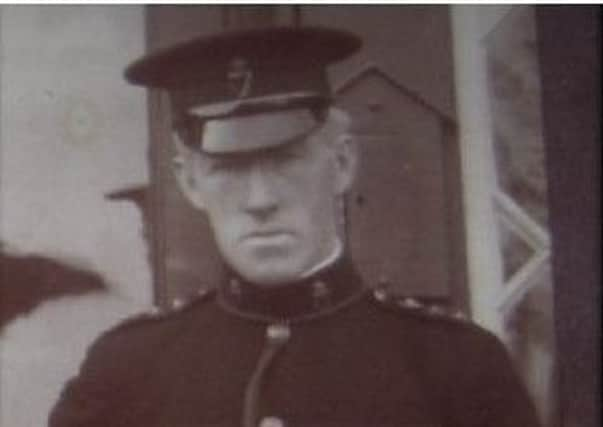RIR man was murdered point-blank – why is there no Irish memorial to him and others like him?


Born on September 3, 1873 , in Co Sligo, son of Martin Hunt, he joined theRIC on January 2, 1893 (serving variously in Longford, Tipperary and Kerry).
He married on May 16, 1900, to Kathleen Mary Bell, daughter of John Bell, Co Kildare and they had six children: his eldest son, Michael John Hunt, went on to receive a commission in the Royal Irish Regiment and prompted to the rank of captain, and later joined the RIC.
Advertisement
Hide AdAdvertisement
Hide AdOn June 23, 1919, DI Michael Hunt performed duty at Thurles Races in charge of a party of RIC men.
At 5.30pm he was walking in uniform in the square at the top of Main Street,
Thurles, when he was fired at three times in quick succession at close range from behind causing him to fall
on the ground face forward.
RIC Sergeant Joseph Grove and Constable Patrick Murphy, who were walking about 15 yards in front of him, rushed back to him at once and carried him to the footpath.
Advertisement
Hide AdAdvertisement
Hide AdWith the crowd dispersing immediately, the murderer made good his escape. DI Hunt was attended to by Dr Thomas Barry who was summoned to the scene and lived nearby, however, DI Hunt died almost immediately.
His body was taken to the home of a Mrs Scully nearby. An investigation it was discovered that three shots were fired at the unfortunate victim, two of which took effect with deadly accuracy, and the third wounded a little boy named Maher in the kneecap.
The shots were fired at very close range, the muzzle possibly almost touching the District Inspector’s back.
At the inquest in Thurles on June 25, 1919 it was revealed in evidence by the witness Sergeant Joseph Grove that when the shots rang out the crowd scattered in all directions.
Advertisement
Hide AdAdvertisement
Hide AdSubsequently a crowd collected round the dying man. District Inspector William Harding Wilson asked: “Did they assist, or do anything?” Witness: “No, they did not”. “Were they jeering and laughing?” “Yes they were.”
One of the wounds severed two of the
largest blood vessels in the body, and directly caused death.
After a short consultation the foreman of the jury said their verdict was that Mr Hunt met his death in accordance with the reasons stated in the medical evidence, and that the bullet wounds were inflicted by person or persons unknown.
District Inspector Wilson asked: “Do they not say it is wilful murder?” The Foreman: “They are not unanimous”. Inspector Wilson: “I don’t know what hesitation they can have about it. It is very plain and clear that Mr Hunt was hit twice in the back. He was not even hit where he could see his assailant. If that is not wilful murder, I don’t know what is”.
Advertisement
Hide AdAdvertisement
Hide AdDistrict Inspector Hunt was buried with full military honours with his coffin covered in the Union Jack in Passlands Cemetery, Monasterevan, Co
Kildare on June 26, 1919 in the family burial ground of his wife.
At Monasterevan station the remains were met by a party of consstabulary as well as son Captain Michael John Hunt, of the Royal Irish Regiment,, who journeyed over from London to attend. A volley was fired over the grave.
On September 9, 1919, he was posthumously awarded a first class favourable record and £5 for good police duty in connection with the successful suppression of a Sinn Fein meeting on May 25, 1919 at Inchiville, Co Tipperary, resulting in the arrest of the Sinn Fein MP for North Monaghan,
Advertisement
Hide AdAdvertisement
Hide AdErnest Blythe was found in possession by DI Hunt of an incriminating document containing directions for intimidating the police from doing their duly by terrorizing their associates and their relatives. The accused denied knowledge of the contents of the document, and repudiated any connection with the policy advocated therein. He was arrested and convicted by court-martial in Dublin and sentenced to 12 months imprisonment.
The Co Tipperary Court Judge Moore in October 1919 awarded £5,800 to
DIHunt’s widow, who had claimed £12,000. The case was appealed and at the Four Courts, Dublin, in March 1920 and his widow and children were awarded £7,800 compensation.
The reason I wrote the article is in the highly advertised ‘Decade of Centenaries’ (ie 1913 to 1923) almost every casualty, both civilian and military, have so far been remembered by way of centenary commemorations of by the erection of numerous memorials. However, no national memorial exists to commemorate the sacrifice made by Irish policemen – ie, the Royal Irish Constabulary and the Dublin Metropolitan Police (DMP), especially during the War of Independence.
Advertisement
Hide AdAdvertisement
Hide AdI am a member of the HARP Society which was founded in 2013 with the objective of obtaining a police memorial in Ireland to remember, not glorify, the lost police lives of the 640 RIC men and 30 DMP men killed on duty between 1836 and 1922 on the island of Ireland. RIC District Inspector Hunt is just but one policeman who deserves such a memorial and to be remembered nationally, by his relatives and the general public.
In the words of Confuscius: “While your father lives, study his wishes. And when he is gone, study his life.”
Jim Herlihy is a historian and author. The commemoration on June 22 will be at 2.30pm at Passlands Cemetery in Monasterevin, Co Kildare. Light refreshments are being supplied afterwards in the Community Centre, Monasterevin (a former RIC barracks)